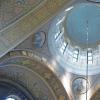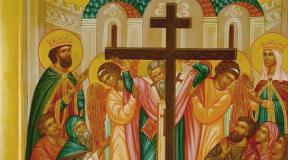Georgian Church and Orthodoxy differences. Orthodoxy and Orthodox shrines in Georgia
Besides St. ap. Andrew in Georgia was preached by St. the apostles Simon the Canaanite and Matthias. The most ancient sources also report on the preaching of St. app. Bartholomew and Thaddeus.
During the first centuries, Christianity in Georgia was persecuted. The martyrdom of St. Sukhi and his squads (commemorated April 15/28). However, already in 326, Christianity became the state religion in Iberia thanks to the preaching of St. equalap. Nina (commemorated January 14/27 and May 19 / June 1 - these days are considered great holidays in the Georgian Church). Fulfilling the will of the Most Holy Theotokos, St. Nina came from Jerusalem to Georgia and finally confirmed the faith of Christ in her.
Initially, the Georgian Church was under the jurisdiction of the Antiochian Patriarchate, but already in the 5th century. according to the established opinion, she received autocephaly. This, apparently, was facilitated, among others, by the fact that Georgia was an independent Christian state outside the borders of the Byzantine Empire. Since the XI century. the primate of the Georgian Church bears the title of Catholicos-Patriarch.
Throughout its history, Georgia fought against invaders who sought not only to seize the country, but also to eradicate Christianity in it. For example, in 1227 Tbilisi was invaded by the Khorezmians led by Jalal-ad-Din. Then the icons were taken out on the bridge and all the inhabitants of the city had to, passing over the bridge, spit on the faces of the icons. Those who did not do this were immediately chopped off and pushed into the river. On that day, 100,000 Christians in Tbilisi were martyred (commemorated on October 31 / November 13).
The plight of the Orthodox Georgians forced them from the 15th century onwards. from time to time to ask for help from the same faith in Russia. As a result, at the beginning of the XIX century. Georgia was annexed to the Russian Empire and the autocephaly of the Georgian Church was abolished. The Georgian Exarchate was formed, which was ruled by an exarch in the rank of metropolitan, and later in the rank of archbishop. During the existence of the Exarchate, order was put in church life, the material situation of the clergy improved, theological educational institutions were opened, and science developed. At the same time, the Georgian language was being squeezed out of the divine services, teaching in seminaries was also conducted in Russian. The number of dioceses was reduced, church property was at the disposal of the Russian authorities, bishops of Russian nationality were appointed as exarchs. All this provoked numerous protests.
In the late XIX - early XX centuries. there was a clearly expressed desire of Orthodox Georgians for autocephaly. In February 1917, a revolution took place in Russia, and on March 12, the restoration of the autocephaly of the Georgian Church was proclaimed in the ancient capital of Georgia, Mtskheta. On September 17, 1917, at the Council in Tbilisi, Bishop Kirion (Sadzaglishvili) was elected as the Catholicos-Patriarch. The Russian Church at first did not recognize the restoration of autocephaly, as a result of which there was a break in prayer communication between the two Churches. Communication was restored in 1943 under Patriarch Sergius (Stargorodsky) and Catholicos-Patriarch Callistratus (Tsintsadze). In 1990, the Ecumenical (Constantinople) Pariarchy recognized the autocephaly of the Georgian Church.
Since 1977 His Holiness and Beatitude Ilia II has been the Catholicos-Patriarch of All Georgia.
17:41, 25 lipnya 2011
4005 0
Georgia (Iveria) - the apostolic lot of the Mother of God. However, the Lord told her to stay in Jerusalem. The Apostle Andrew the First-Called went to the north ...
In the Caucasus, between the Black and Caspian Seas, there is a country of the most ancient history and culture - Georgia. The beauty of Georgian nature, the originality of Georgian art and the inimitable flavor of the Georgian character delighted great poets and famous travelers. At the same time, it is one of the most ancient Christian countries in the world, which is impossible to imagine without holy Orthodoxy.
Throughout its history, Georgia fought against invaders who sought not only to enslave the country, but also to eradicate Christianity in it. Many conquerors were close to destroying Orthodox Iberia. But the Christ-loving Georgian people defended their homeland and preserved the right faith. Georgia is still one of the outposts of Orthodoxy in the modern world.
Lot of the Most Holy Theotokos
Georgia (Iveria) - the apostolic lot of the Mother of God. According to church tradition, after the Ascension, the apostles gathered in the upper room of Zion and cast lots in which country each of them should go. The Blessed Virgin Mary wished to take part in the apostolic preaching. She had the lot to go to Iberia, but the Lord told Her to stay in Jerusalem. The Apostle Andrew the First-Called went to the north, who took with him the image of the Virgin.
The holy apostle went to that country that kept the great Old Testament shrine - the mantle of the prophet Elijah. There it was brought by the Jews, persecuted by the Babylonian king Nebuchadnezzar. In addition, the greatest Christian shrine was located in Georgia - the unsewn tunic of our Lord Jesus Christ, which was brought to Mtskheta, the ancient capital of Georgia, by a local resident, the Jew Elioz, who was present at the crucifixion.
In the Apostolic times, two Georgian states existed on the territory of modern Georgia: East Georgian Kartli (in Greek Iveria) and West Georgian Egrisi (in Greek Colchis). The Apostle Andrew preached in both Eastern and Western Georgia.
In the city of Atskuri (near modern Akhaltsikhe), at the prayer of the apostle, the son of a widow who died shortly before his arrival was resurrected, and this miracle prompted the inhabitants of the city to accept holy baptism... The Apostle Andrew appointed a bishop, priests and deacons to the newly enlightened, and before leaving on his journey he left in the city an icon of the Most Holy Theotokos, which had been in the Cathedral for many centuries.
In Western Georgia, together with the Apostle Andrew, the teaching of Christ was preached by the Apostle Simon the Canaanite, who was buried there, in the village of Koman. The Georgian land received another apostle, Saint Matthias, he preached in the south-west of Georgia and was buried in Gonio, near modern Batumi. Besides, oldest sources indicate the presence of the Apostles Bartholomew and Thaddeus in Eastern Georgia.
Baptism of Iberia
The preaching of the holy apostles did not pass without leaving a trace. The first christian communities and churches. An interesting fact is that in the works of Saint Irenaeus of Lyons (II century), the Ivers (Georgians) are already mentioned among the Christian peoples.
However, the mass baptism of Georgians took place only at the beginning of the 4th century thanks to the preaching of St. Nina, an educator of Georgia. Originally from Cappadocia, a relative of the Great Martyr George, Saint Nina arrived from Jerusalem in fulfillment of the will of the Most Holy Theotokos.
The preacher drew the attention of the people to the holiness of life, as well as many miracles, in particular, the healing of the queen from illness. When King Mirian, endangered on a hunt, was saved after praying to the Christian God, then, having safely returned home, he adopted Christianity with his entire house and himself became a preacher of the teachings of Christ among his people.
In 326, Christianity in Georgia was proclaimed the state religion. King Mirian built a temple in the name of the Savior in the capital of the state - Mtskheta, and on the advice of Saint Nina sent ambassadors to Saint Constantine the Great with a request to send a bishop and clergy. Bishop John sent by Saint Constantine and the Greek priests continued the conversion of the Georgians.
Before the arrival of the clergy in Mtskheta, where the Lord's tunic was kept, the construction of the church had already begun. This place is still the center of the spiritual life of the Georgian people. There is a cathedral in honor of the Twelve Apostles - “Svetitskhoveli” (“Life-Giving Pillar”).
The successor to the glorified in the saints King Mirian - King Bakar (342–364) also worked a lot in the Christianization of the country. Under him, liturgical books were translated into Georgian.
Since that time, Georgians have become faithful followers of Christ and have always unwaveringly defended Orthodox teaching. Byzantine historian of the 6th century Procopius of Caesarea notes that "the Ivers are Christians, and they observe the rules of faith better than everyone we know."
In the struggle for Orthodoxy
Georgia reached its power in the 5th century. under King Vakhtang I Gorgosali, who ruled the country for fifty-three years. Successfully defending the independence of his homeland, he did a lot for the Church. Under him was rebuilt collapsed at the beginning of the V century. Mtskheta temple.
With the transfer of the capital of Georgia from Mtskheta to Tiflis, Vakhtang I laid in the new capital the foundation of the famous Zion Cathedral that still exists today. Under Tsar Vakhtang I, according to Georgian historians, 12 episcopal sees were opened. Through the care of his mother Sagdukht, the widow of King Archil I, in 440 the books of the Holy Scriptures of the New Testament were translated into Georgian for the first time.
Initially, the Georgian Church was under the jurisdiction of the Patriarchate of Antioch, but already in the 5th century, according to the established opinion, it received autocephaly. This, apparently, was facilitated, among others, by the fact that Georgia was an independent Christian state outside the borders of the Byzantine Empire. Since the XI century. the primate of the Georgian Church bears the title of Catholicos-Patriarch. (Catholicos - Greek “universal”, indicates that the jurisdiction of the Georgian Church extends not only to the borders of Georgia, but also to all Georgians, wherever they live. - Ed.)
Since the adoption of Christianity, the Georgian people for centuries had to fight almost constantly against external enemies, who, together with the conquest of the country, tried to destroy the Christian religion. In the hardest struggle, the Georgian people were able to preserve their statehood and defend Orthodoxy. For centuries, the struggle for statehood has been identified with the struggle for Orthodoxy. Many people, both clergy and laity, were martyred for their faith in Christ.
World history does not know such an example of self-sacrifice, which was shown by the inhabitants of the capital of Georgia, Tbilisi in 1227, when at the same time 100 thousand people - men, children and the elderly - refused to obey the order of the Khorezm Shah Jalal-ed-din - to desecrate the icons placed on bridge, received a martyr's crown.
In the crucible of trials, the faith and courage of the Georgian people were only strengthened. The flowering of Christian Iberia was brought about by the reign of the God-fearing King David IV (c. 1073–1125) and his pious descendants.
Golden age
At the dawn of its Christian history, Georgia was forced to wage a centuries-old bloody struggle with Islam, the carriers of which were, first of all, the Arabs. Since the VII century. they seized vast lands of the Persian and Byzantine empires, weakened by mutual strife. In the VIII century. Georgia has undergone terrible devastation by the Arabs led by Murvan, nicknamed "Deaf" for his ruthlessness. A new wave of violence broke out in the second half of the 11th century, when the Seljuk Turks invaded Georgia, destroying churches, monasteries, settlements and the Orthodox Georgians themselves.
The position of the Iberian Church changed only with the accession to the royal throne of David IV the Builder (1089–1125), a clever, enlightened and God-fearing ruler. David IV put in order church life, built churches and established monasteries. In 1103, on his initiative, a council was convened in Ruisi, the decrees of which contributed to the strengthening of the canonical life of the Church and the establishment of church deanery.
The zenith of Georgia's glory was the century of the famous great-granddaughter of David, the holy queen Tamara (1184-1213), who was able not only to preserve what was under her predecessors, but also to expand her state from the Black to the Caspian Sea. After the capture of Constantinople by the crusaders in 1204, Georgia became the most powerful Christian state in the entire Eastern Mediterranean.
Legendary tales associate with the name of Queen Tamara almost all the remarkable monuments of the history of Georgia, including many towers and churches on the tops of the mountains. The saint was especially concerned about the enlightenment of her people. In her reign appears big number orators, theologians, philosophers, historians, artists and poets. However, with the death of Saint Tamara, everything changed - she seemed to take it with her to the grave happy years their homeland.
Under the blows of enemies
The Mongol-Tatars who converted to Islam became a threat for Georgia. In 1387 Tamerlane entered Kartalinia, bringing with him destruction and devastation. “Georgia was a terrible sight then,” writes the priest Nikandr Pokrovsky. - Cities and villages in ruins, corpses were lying in heaps in the streets. It seemed that the fiery river rushed through sad Georgia. Even after that, her sky was repeatedly illuminated by the glow of Mongol fires, and the steaming blood of its ill-fated population in a long strip marked the path of the formidable and cruel ruler of Samarkand. "
Following the Mongols, the Ottoman Turks brought suffering, the destruction of shrines and the forcible conversion to Islam to the Georgians.
A long series of calamities suffered by Georgia over its 1,500-year history ended with the devastating invasion of the Persian Shah Agha-Mohammed in 1795. On the day of the Exaltation of the Holy Cross, the Shah ordered to seize all the clerics of Tiflis and throw them from the high bank into the Kura River. In cruelty, this execution is equal to the bloody massacre perpetrated on Easter night in 1617 in the Gareja monastery, when, by order of the Persian Shah Abbas, his soldiers killed six thousand monks. "The Kingdom of Georgia," writes the historian Platon Ioseliani, "for fifteen centuries has not represented almost a single government that would not have been marked by either attack, or devastation, or cruel oppression by the enemies of Christ."
In times of disaster for Iberia, intercessors ordinary people monks and white clergy came forward. “It is hardly possible to find in the history of mankind any political or ecclesiastical society,” wrote Bishop Kirion (Sadzaglishvili, later Catholicos-Patriarch), “which would sacrifice more and shed more blood in defense of orthodox faith and nationalities, than the Georgian clergy and especially monasticism did. Due to the tremendous influence of Georgian monasticism on the fate of the Patriotic Church, its history has become an integral and most important part of Georgian church-historical life, its valuable adornment, without which the history of subsequent centuries would be colorless, incomprehensible, lifeless. "
Together with Russia
The plight of Orthodox Georgians forced them to turn to the same faith Russia for help. Beginning in the 15th century, these appeals did not stop until the annexation of Georgia to the Russian Empire. In response to the request of the last kings - George XII in Eastern Georgia and Solomon II in Western Georgia - on September 12, 1801, Emperor Alexander I issued a manifesto by which Georgia - first Eastern and then Western - was finally annexed to Russia.
After reunification, the Georgian Church became part of the Russian Orthodox Church as an exarchate. In 1811, according to the imperial order, the exarch of Iberia was appointed instead of the Catholicos, who received the right to be a member of the Holy Synod.
During the existence of the exarchate, order was restored in church life, the material situation of the clergy improved, theological educational institutions were opened, and science developed. At the same time, the Georgian language was gradually being squeezed out of the divine services, teaching in seminaries was also conducted in Russian. There were also questions related to church property.
Autocephalous Georgian Orthodox Church
In the late XIX - early XX centuries. there was a clearly expressed desire of Orthodox Georgians for autocephaly. In February 1917, a revolution took place in Russia, and on March 12, the restoration of the autocephaly of the Georgian Church was proclaimed in the ancient capital of Georgia Mtskheta. On September 17, 1917, at the Council in Tbilisi, Bishop Kirion (Sadzaglishvili) was elected Catholicos-Patriarch. The Russian Church at first did not recognize the restoration of autocephaly, as a result of which there was a break in prayer communication between the two Churches. Communication was restored in 1943 under Patriarch Sergius (Stragorodsky) and Catholicos-Patriarch Callistratus (Tsintsadze). In 1990, the Ecumenical (Constantinople) Patriarchate recognized the autocephaly of the Georgian Church.
Currently, the Georgian Church has about three million believers, 27 dioceses, 53 monasteries, about 300 parishes. Divine services are performed in Georgian, in some parishes - in Church Slavonic or Greek.
The Orthodox Church occupies a special place in modern Georgia. The state recognizes a marriage registered by the Church, ensures the activities of the institute of chaplains in the army and prisons, teaching the basics of the Orthodox faith in educational institutions, and recognizes diplomas of theological schools. In turn, the Church approves projects orthodox churches and issues a permit for their construction, her property is exempt from taxes. All great orthodox holidays declared state in Georgia and are days off. Orthodox Iberia lives and looks to the future with hope.
Oleg Karpenko, "Church Orthodox Newspaper"
Yaksho vi knew the pardon, see it as a bear and natisnit Ctrl + Enter
Chapter I. Georgian Orthodox Church
The jurisdiction of the Georgian Orthodox Church extends to Georgia. However, “it is customary in the Georgian Church,” says Metropolitan of Sukhum-Abkhaz (now Catholicos-Patriarch) Elijah in his reply dated August 18, 1973 to a letter of inquiry from the author of this work, “that the jurisdiction of the Georgian Church extends not only to the borders of Georgia, but to all Georgians, wherever they live. An indication of this is the presence of the word "Catholicos" in the title of the Primate.
Georgia is a state located between the Black and Caspian Seas. From the west it is washed by the Black Sea and has common borders with Russia, Azerbaijan, Armenia and Turkey.
Area - 69.700 sq. Km.
Population - 5.201.000 (for 1985).
The capital of Georgia is Tbilisi (1,158,000 inhabitants in 1985).
History of the Georgian Orthodox Church
1. The oldest period in the history of the Georgian Orthodox Church
:baptism of Georgians; the concerns of the rulers of Georgia about the organization of the Church; the question of autocephaly; the destruction of the Church by the Mohammedans and Persians; patrons of the Orthodox people- clergy and monasticism; Catholic propaganda; establishment of the AbkhazCatholicosate; seeking help from the same faith in Russia
According to legend, the first preachers of the Christian faith on the territory of Georgia (Iberia) were the holy apostles Andrew the First-Called and Simon the Canaanite. “We think that these legends, - writes the researcher Ancient history Iberian Gobron (Mikhail) Sabinin of their Church, - have the same right to be heard and taken into consideration as the traditions of other Churches (for example, the Greek, Russian, Bulgarian, etc.), and that the fact of the direct apostolic foundation of the Georgian Church can be proved on the basis of these traditions with the same degree of probability with which it is proved with respect to other Churches, on the basis of similar facts. " One of the Georgian chronicles tells the following about the embassy of Saint Andrew to Iberia: “After the Lord's ascension into Heaven, the Apostles with Mary, the Mother of Jesus, gathered in the Zion upper room, where they awaited the coming of the promised Comforter. Here the Apostles cast lots where to go with the preaching of the Word of God. During the casting of lots, the Blessed Virgin Mary said to the Apostles: "I wish I too to accept the lot with you, so that I also have a country that God Himself will give Me." Lots were cast, according to which the Blessed Virgin went to the inheritance of Iberia. The Lady with great joy accepted Her lot and was already ready to go there with the word of preaching, when just before Her departure the Lord Jesus appeared to Her and said: “My mother, I will not reject Your lot and I will not leave Your people without participation in heavenly good; but send instead the First-Called Andrew to your inheritance. And send with him your image, which will be depicted by attaching the board prepared for that to your face. That image will replace You and serve as the keeper of Your people forever. " After this divine appearance, the Most Holy Virgin Mary called to Herself the holy Apostle Andrew and conveyed to him the words of the Lord, to which the Apostle only answered: "The holy will of Thy Son and Thy will be forever." Then the Most Holy One washed Her face, demanded a board, put it to Her face, and the image of the Lady with Her Eternal Son in her arms was reflected on the board. "
On the verge of the 1st-2nd centuries, according to the testimony of the historian Baronius, the Tauric Hierarch Clement, Bishop of Rome, sent by Emperor Trajan into exile in Chersonesos, “led to the gospel truth and salvation” of local residents. "A little later than this time," adds to this the historian of the Georgian Church Platon Josselian, "the natives of Colchis Palms, Bishop of Pontic, and his son, the heretic Marcion, arose in the Church of Colchis, against whose delusions Tertullian armed himself."
In subsequent years, Christianity was supported "firstly ... by Christian missionaries leaving the bordering Christian provinces ... and secondly ... the frequent clashes of Georgians with Greek Christians favored and introduced the pagans of Georgians to Christian teaching."
The mass baptism of Georgians took place at the beginning of the 4th century thanks to the equal-to-the-apostles' labors of Saint Nina (born in Cappadocia), to whom the Mother of God appeared in a dream, presented a cross of grape vines and said: “Go to the Iberian country and preach the Gospel; I will be your Patroness. " Waking up, Saint Nina kissed the miraculously received cross and bandaged it with her hair.
Arriving in Georgia, Saint Nina soon attracted the attention of the people with her holy life, as well as many miracles, in particular, with the healing of the queen from illness. When King Mirian (O 42), having been in danger on a hunt, called for help from the Christian God and received this help, then, having safely returned home, he adopted Christianity with his entire house and himself became a preacher of the teachings of Christ among his people. In 326, Christianity was proclaimed the state religion. King Mirian built a temple in the name of the Savior in the capital of the state - Mtskheta, and on the advice of Saint Nina sent ambassadors to Saint Constantine the Great, asking him to send a bishop and clergy. Bishop John sent by Saint Constantine and the Greek priests continued the conversion of the Georgians. The successor to the glorified in the saints King Mirian - King Bakar (342-364) also worked a lot in this field. Under him, some of the liturgical books were translated from Greek into Georgian. The foundation of the Tsilkan diocese is associated with his name.
Georgia reached its power in the 5th century under the king Vakhtang I Gorgaslan, who ruled the country for fifty-three years (446-499). Successfully defending the independence of his homeland, he did a lot for his Church. Under him, the Mtskheta temple, which had collapsed at the beginning of the 5th century, was rebuilt, dedicated to the Twelve Apostles.
With the transfer of the capital of Georgia from Mtskheta to Tiflis, Vakhtang I laid in the new capital the foundation of the famous Zion Cathedral that still exists today.
Under Tsar Vakhtang I, according to Georgian historians, 12 episcopal sees were opened.
Through the care of his mother Sandukhta, the widow of King Archil I (413 - 434), the books of the Holy Scriptures of the New Testament were first translated into Georgian in about 440.
In the middle of the 6th century, a number of churches were built in Georgia and an archbishop's chair was established in Pitsunda.
The issue of the time when the Georgian Orthodox Church received autocephaly is somewhat complicated due to the lack of the necessary documents.
The famous Greek canonist of the XII century Patriarch of Antioch Theodore Balsamon, commenting on the second rule of the Second Ecumenical Council, says: “The Archbishop of Iveron was honored with independence by the definition of the Council of Antioch. They say that in the days of Lord Peter, Holy Patriarch Theopolis, i.e. Great Antioch, there was a council order that the Iberian Church, then subordinate to the Patriarch of Antioch, should be free and independent (autocephalous). "
This vague phrase of Balsamon is understood in different ways. Some are inclined to think that the definition was under Patriarch Peter II of Antioch (5th century), others - under Patriarch Peter III (1052-1056). Hence, the announcement of autocephaly is attributed to different periods. For example, the Locum Tenens of the Moscow Patriarchal Throne, Metropolitan Pimen of Krutitsky and Kolomna, in his letter of August 10, 1970 addressed to Patriarch Athenagoras (correspondence on the occasion of the granting of autocephaly to the Orthodox Church in America) wrote that the independence of the Church of Iberia “was established by its Mother - the Church of Antioch - in 467 (see about this interpretation of Balsamon on the 2nd rule of the Second Ecumenical Council). " The former Primate of the Greek Orthodox Church, Archbishop Jerome, on the question of the time of the proclamation of autocephaly by the Georgian Orthodox Church, is inclined to think that in 556 the solution of this issue by the Antiochian
The Synod was still inconclusive, and in 604 this decision was recognized by other Patriarchs. “The fact,” he wrote, “that the autocephalous status of the Church of Iberia was not recognized by all the other Holy Churches until 604, is clear evidence that the decision of the Synod of Antioch was nothing more than a proposal on this issue and a temporary approval, without which however, the secession of any part of the jurisdiction of the Patriarchal throne would never have been the object of attempts. In any case, we agree with the opinion that the decision of the Synod in Antioch and the recognition by the rest of the Churches of the autocephalous status of the Church of Iberia, unjustifiably late for unknown reasons, are historically completely unclear.
According to the calendar of the Greek Orthodox Church for 1971, autocephaly of the Georgian Orthodox Church was proclaimed by the Sixth Ecumenical Council, and “from 1010
years the head of the Georgian Church bears the following title: His Holiness and Beatitude Catholicos-Patriarch of All Georgia. The first Catholicos-Patriarch was Melchizedek I (1010-1045). " And the Archbishop of Brussels and Belgium, Basil (Krivoshey), declares: “The Georgian Orthodox Church, which was dependent on the Antiochian Patriarchate since the 5th century, autocephalous from the 8th century, became Patriarch in 1012, and since then its head has the traditional title of“ Catholicos- Patriarch ", was deprived of autocephaly in 1811 by a unilateral act of the Russian imperial power, after Georgia was incorporated into Russia."
Georgian church leaders (Bishop Kirion - later Catholicos-Patriarch, Hierodeacon Elijah-now Catholicos-Patriarch) believe that until 542 the Mtskheta-Iberian Primates were confirmed in their rank and dignity by the Antiochian Patriarch, but from that time the Iberian Church was the letter of the Greek emperor recognized as Autocephalous. This was done with the consent of Patriarch Mina of Constantinople, as well as all other Eastern First Hierarchs, and was approved by a special definition of the Sixth Ecumenical Council, which decreed: “To recognize the Mtskheta Church in Georgia as equal in dignity and honor with the holy Apostolic Catholic and Patriarchal Thrones, granting the Iberian Catholic equal to the Patriarchs and have authority over archbishops, metropolitans and bishops throughout the Georgian region. "
Catholicos-Patriarch of All Georgia David V (1977) expresses the same opinion as the Primate of the Russian Orthodox Church on the question of the time of the announcement of autocephaly of the Georgian Church. “In the 5th century,” he says, “under the famous king Vakhtang Gore-Haslan, the founder of Tbilisi, our Church was granted autocephaly.”
Priest K. Tsintsadze, specially studying the question of the autocephaly of his Church, as if summarizing everything stated above, asserts that the Georgian Church has been almost independent since the time of King Mirian, but received full autocephaly only in the 11th century from the Council of Metropolitans, Bishops and Noble Antiochians. convened by Patriarch Peter III of Antioch. Here are his words: “The Council chaired by Patriarch Peter, taking into account ... the fact that a) Georgia was“ enlightened ”by the preaching of two Apostles, b) it has been ruled by almost independent archbishops since the time of Tsar Mirian, c) since the time of Tsar Vakhtang Gorgaslan ( 499) she received Catholicos from Byzantium with the rights of the same archbishops, d) from the time of Tsar Parsman U1 (557) Catholicos were chosen already in Georgia from natural Georgians and were only ordained in Antioch, d.) From the days of the Martyr Anastasius (610) Catholicos were ordained already in Georgia, which, however, did not entail any special unrest, f) since the time of Patriarch (Antioch. - K.S.) Theophylact (750) Georgians received the formal right to appoint Catholicos for themselves at the Councils of their bishops in Georgia - and that the Georgian Catholicos worried mainly interference
Patriarchal exarchs and abbots in the affairs of their Church ", finally, taking into account also the fact that" modern Georgia is the only Orthodox state in the East (moreover, it is quite powerful and well-equipped), therefore she does not want to endure outside guardianship ... granted the Georgian Church full autocephaly. " “None of the subsequent Patriarchs of Theopolis,” concludes the priest K. Tsintsadze, “did not dispute this independence of the Georgian Church, and it, starting from the eleventh century (more precisely, from 1053), enjoyed this independence continuously until 1811”. The opinion of the Metropolitan of Sukhum-Abkhaz (now Catholicos-Patriarch) Elijah is also a generalizing judgment on the question of the time when the autocephaly of the Georgian Church was obtained. In the above-mentioned letter dated August 18, 1973, He says: “Autocephaly is complex issue and requires a lot of painstaking work with manuscripts, most of which have not yet been published ... The history of the Georgian Church suggests that the official act of granting the Georgian Church autocephaly dates back to the middle of the 5th century, at the time of the primacy of Patriarch Peter II of Antioch (Knafei) and the Georgian Catholicos -Archbishop Peter I. Of course, the Church of Antioch could not immediately grant all rights to the Georgian Autocephalous Church. Conditions were set: the commemoration of the name of the Patriarch of Antioch at the divine services, the annual material donation from the Georgian Church, the taking of Holy Peace from Antioch, etc. All these issues were resolved in subsequent times. Therefore, historians disagree about the timing of the granting of autocephaly.
So, the Georgian Church received autocephaly in the 5th century from the Church of Antioch, in whose legal subordination it was. The Georgian Church has never been legally subordinate to the Church of Constantinople. On the Black Sea coast of Georgia, after the preaching of the holy apostles Andrew the First-Called and Simon the Canaanite, many adopted Christianity; even dioceses were founded here. In the acts of the First Ecumenical Council, among other bishops, Stratophilus, Bishop of Pitsunda, and Domnos, Bishop of Trebizond, are mentioned. There is evidence of subsequent centuries that the dioceses of Western Georgia for some time submitted to the Constantinople throne.
What was the situation in Eastern Georgia?
After the sermon and miracles of Saint Nina, Tsar Mirian, after believing in Christ, sends a delegation to Constantinople with a request to send the clergy. Saint Mirian could not pass Constantinople and the emperor, since this was not only a religious issue, but also an act of great political significance. Who came from Constantinople? There are two opinions. 1. According to the chronicle "Kartlis tskhovrebo" and the history of Vakhushti, Bishop John, two priests and three deacons arrived from Constantinople. 2. According to the testimony of Ephraim the Lesser Philosopher (XI century) and by order of the Ruiss-Urbnis Council (1103), at the behest of Emperor Constantine, Patriarch Eustathius of Antioch arrived in Georgia, who installed the first bishop in Georgia and performed the first baptism of Georgians.
Most likely, these two information complement each other. It can be assumed that Patriarch Eustathius of Antioch arrived in Constantinople, where he received appropriate instructions from the emperor and ordained Bishop John, priests and deacons. Then he arrived in Georgia and founded the Church. From that time on, the Georgian Church entered the jurisdiction of the Antioch throne. "
It is natural to believe that from the time of its autocephalous existence, the Iberian Church, headed and led by Georgians, had to enter a phase of gradual improvement. However, this did not happen, since At the dawn of its independent church life, Georgia was forced to begin a centuries-old bloody struggle against Islam, which was carried primarily by the Arabs.
In the VIII century, the whole country was subjected to terrible devastation from the Arabs led by Murvan. The rulers of Eastern Imereti Argvetian princes David and Constantine bravely met the advance detachments of Murvan and won a victory over him. But Murvan put all his forces on them. After the battle, the brave princes were taken prisoner, subjected to cruel torture, and thrown off a cliff into the Rion River (Comm. 2 October).
By the 10th century, Islam was implanted in a number of places in Georgia, but not among the Georgians themselves. According to the priest Nikandr Pokrovsky, referring to the message of the Arab writer Masudi, in 931 the Ossetians destroyed their christian temples and adopted Mohammedanism.
In the 11th century, countless hordes of Seljuk Turks invaded Georgia, destroying temples, monasteries, settlements and the Orthodox Georgians themselves on their way.
The position of the Iberian Church changed only with the accession to the royal throne of David IV the Builder (1089-1125), an intelligent, enlightened and God-fearing ruler. David IV put in order church life, built temples and monasteries. In 1103, he convened a Council, at which the Orthodox confession of faith was approved and the canons concerning the conduct of Christians were adopted. Under him, "the long silent mountains and valleys of Georgia resounded again with the solemn ringing of church bells, and instead of sobs, songs of cheerful villagers were heard."
In his personal life, according to the Georgian chronicles, Tsar David was distinguished by high Christian piety. His favorite pastime was reading spiritual books. He never parted with the Holy Gospel. The Georgians reverently buried their pious king in the Gelati monastery he had created.
The zenith of Georgia's glory was the century of the famous great-granddaughter of David, the holy Queen Tamara (1184 -1213). She was able not only to preserve what was under her predecessors, but also to expand her power from the Black to the Caspian Sea. The legendary legends of Georgia attribute to Tamara almost all the remarkable monuments of the past of their people, including many towers and churches on the mountain tops. Under her, a large number of educated people, orators, theologians, philosophers, historians, artists and poets appeared in the country. Works of spiritual, philosophical and literary content were translated into Georgian. However, with the death of Tamara, everything changed - she seemed to take the happy years of her homeland with her to the grave.
Mongol-Tatars became a threat for Georgia, especially after they converted to Islam. In 1387, Tamerlane entered Kartalinia, bringing with him destruction and devastation. “Georgia then presented a terrible sight,” writes the priest N. Pokrovsky. - Towns and villages - in ruins; corpses lay in heaps in the streets: the stench and stench from their rotting contaminated the air and drove people away from their former dwellings, and only predatory animals and bloodthirsty birds feasted at such a meal. The fields were trampled and burnt, the people scattered across the forests and mountains, for a hundred miles there was no human voice. Those who escaped from the sword died of hunger and cold, for a merciless fate befell not only the inhabitants themselves, but all their property. It seemed that
the fiery river rushed through sad Georgia. Even after that, its sky is repeatedly illuminated by the glow of Mongol fires, and the steaming blood of its ill-fated population in a long strip marks the path of the formidable and cruel ruler of Samarkand. "
Following the Mongols, the Ottoman Turks brought suffering to the Georgians, the destruction of the shrines of their Church and the forcible conversion of the peoples of the Caucasus to Islam. Dominican John of Lukk, who visited the Caucasus around 1637, spoke about the life of his peoples: “Circassians speak Circassian and Turkish; some of them are Mohammedans, others are Greek. But the Mohammedan is more ... The number of Muslims is increasing every day. "
A long series of disasters suffered by Georgia over its 1500-year history ended in a devastating invasion of
1795 by the Persian Shah Agha Mohammed. Among other atrocities, the shah ordered on the day of the Exaltation of the Cross of the Lord to seize all the clergy of Tiflis and throw them from the high bank into the Kura River. In cruelty, this execution is equal to the bloody massacre perpetrated in 1617, on Easter night, over the Gareja monks: by order of the Persian Shah Abbas, six thousand monks were hacked to death within a few moments. "The Kingdom of Georgia," writes Plato Josselian, "for fifteen centuries has not represented almost a single reign that would not have been marked either by attack, or by ruin, or by cruel oppression by the enemies of Christ."
In times distressing for Iberia, monks and white clergy acted as intercessors of ordinary people, strong in faith and hope for God, who themselves emerged from the depths of the Georgian people. Sacrificing their lives, they courageously defended the interests of their people. When, for example, the Turks invading the borders of Georgia seized the priest Theodore in Quelt and, under threat of death, demanded that he show them the place where the Georgian king is, this Georgian Susanin decided: “I will not sacrifice eternal life for the sake of temporary, I will not be a traitor to the king ”and led the enemies into the impenetrable jungle of mountains.
Another example of courageous intercession for his people before the Muslim enslavers was shown by his act by Catholicos Domentius (18th century). Motivated by a deep love for the holy Orthodox faith and for his fatherland, he appeared to the Turkish Sultan in Constantinople with a bold intercession for his Church and for his people. The courageous defender was slandered at the Sultan's court, sent into exile to one of the Greek islands, where he died.
“It is hardly possible to find in the history of mankind any political or ecclesiastical society,” writes Bishop Kirion, “which would sacrifice more and shed more blood in defense of the Orthodox faith and nationality than the Georgian clergy and especially monasticism did. Due to the enormous influence of Georgian monasticism on the fate of the patriotic Church, its history has become an integral and most important part of Georgian church-historical life, its valuable decoration, without which the history of subsequent centuries would be colorless, incomprehensible, lifeless. "
But the Arabs, Turks and Persians inflicted mainly physical blows on Orthodox Georgia. At the same time, she was in danger from the other side - from the Catholic missionaries, who set the goal of converting Georgians to Catholicism and submitting them to the Pope.
Starting from the 13th century - from the day Pope Gregory IX sent Dominican monks to Georgia in response to the request of Queen Rusudan (daughter of Queen Tamara) to provide military assistance in the fight against the Mongols - until the first decades of the 20th century, persistent Catholic propaganda was carried out in Georgia. “The popes - Nicholas IV, Alexander VI, Urban VIII and others,” writes Meliton Fomin-Tsagareli, “sent various exhorting messages to the Georgian kings, metropolitans and nobles, seeking to somehow persuade the Georgians to their religion, and Pope Eugene IV was already final dreamed of fulfilling the desire of the Roman high priests at the Florentine Council, using the strongest convictions over the Georgian metropolitan; but all attempts by Catholics to persuade Georgians to recognize their religion were in vain. "
Even in 1920, a representative of the Catholic Church arrived in Tiflis, who proposed to Catholicos Leonid to accept the leadership of the pope. Despite the fact that his proposal was rejected, JB in 1921, the Vatican appointed Bishop Moriondo as its representative for the Caucasus and Crimea. At the end of the same year, Rome appointed the bishop of Smets to this position. Together with him, a large number of Jesuits arrived in Georgia, who roamed the ancient country, recommending themselves as archaeologists and paleographers, but in fact trying to find a fertile ground for the spread of the ideas of papism. The Vatican's attempts this time ended in vain. In 1924 Bishop Smete left Tiflis and went to Rome.
The establishment of two Catholicosates in Georgia in the 14th century in connection with the division of the country into two kingdoms - Eastern and Western - also violated the order of church life. One of the Catholicos had his residence in Mtskheta at the Cathedral of Sveti-Tskhoveli and was called Kartala, Kakheti and Tiflis, and the other - first in Bichvint (in Abkhazia) at the Mother of God, erected in the VI century by Emperor Justinian, and then, from 1657, in Kutaisi was called first (since 1455) Abkhaz and Imereti, and after 1657 - Imereti and Abkhaz. When in 1783 the king of Kartala and Kakheti Irakli II formally recognized the patronage of Russia over Georgia, the Imeretino-Abkhaz Catholicos Maxim (Maxim II) retired to Kiev, where he died in 1795. Higher management The Church of Western Georgia (Imeretia, Guria, Mingrelia and Abkhazia) passed to the Metropolitan of Gaenat.
The plight of Orthodox Georgians forced them to turn to the same faith Russia for help. Starting in the 15th century, these appeals did not stop until the annexation of Georgia to Russia. In response to the request of the last kings - George XII (1798-1800) in Eastern Georgia and Solomon II (1793-1811) in Western Georgia - on September 12, 1801, Emperor Alexander I issued a manifesto, which Georgia - first Eastern, and then Western - was finally annexed to Russia. “The enthusiasm of the Georgians,” writes Bishop Kirion, “upon receiving this manifesto of accession, defies description.
All of a sudden everything was reborn and revived in Georgia ... Everyone rejoiced at the accession of Georgia to Russia. "
The memory of the courageous thousand-year struggle of the Georgian people with their numerous enemies is glorified in Georgian folk legends, in the works of the Georgian poet Shota Rustaveli (XII century), in the poems of King Archil II of Imereti and Kakheti (1647-1713).
The page was generated in 0.03 seconds!
Georgia (cargo. საქართველო , Sakartvelo) is a state located in Western Asia and the Middle East, in the western part of the Caucasus on the eastern coast of the Black Sea. Georgia shares borders with Armenia and Turkey in the south, Azerbaijan in the southeast and Russia in the east and north. The capital is Tbilisi. The state language is Georgian.
Largest cities
- Batumi
- Kutaisi
Georgian Orthodox Church
Georgian Orthodox Church (official name: Georgian Apostolic Autocephalous Orthodox Church, cargo. საქართველოს სამოციქულო ავტოკეფალური მართლმადიდებელი ეკლესია ) - autocephalous local orthodox Church, which has the sixth place in the diptychs of Slavic local Churches and the ninth in the diptychs of the ancient Eastern patriarchates. One of the oldest Christian churches in the world. Jurisdiction extends to the territory of Georgia and to all Georgians, wherever they live, as well as to the territory of the partially recognized Abkhazia and South Ossetia and to the north of Turkey. According to a legend based on an ancient Georgian manuscript, Georgia is the apostolic lot of the Mother of God. In 337, through the works of St. Nina, Equal to the Apostles, Christianity became the state religion of Georgia. The church organization was located within the Antioch Church. The issue of obtaining autocephaly by the Georgian church is difficult. According to the historian of the Georgian church, priest Kirill Tsintsadze, the Georgian Church enjoyed de facto independence from the time of King Mirian, but received full autocephaly only in the 5th century from the Council convened by Patriarch Peter III of Antioch.
Article 9 of the Georgian Constitution reads: "The state recognizes the exclusive role of the Georgian Orthodox Church in the history of Georgia and at the same time proclaims complete freedom of religious beliefs and confession, the independence of the church from the state."
History
Early period
According to Georgian legendary history, Georgia is the apostolic lot of the Mother of God.
Soon after this event, the Apostle Andrew set out to preach Christianity. First, he went north from Palestine, then turned east, reached the city of Trebizond, which was at that time within Egrisi (modern Mingrelia), after preaching the Gospel there, he moved to Iberia, to the land of Did-Adchara.
There the Apostle, by preaching and performing miracles, converted many people to Christianity and baptized them. According to the story of Tsarevich Vakhushti, the son of Tsar Vakhtang V, in the place where the Apostle Andrew placed the icon of the Mother of God, a healing spring was opened. Having appointed priests and deacons to newly converted Christians, built a church in honor of the Mother of God and established church order, the apostle left them.
Before the departure of Saint Andrew from that land, the converts asked him to leave the icon of the Mother of God, but the apostle did not agree to such a request, but ordered that a board be made as large as this icon and brought to him. When the board was ready, he put it on the icon of the Mother of God, and the icon was completely depicted on the board. The apostle gave Christians a new image, which they put in their new church. Then Saint Andrew went to other lands.
Crossing the mountain called the Iron Cross Mountain and the Dzarchi gorge, he entered Samtskhe and stopped in the village of Zaden Gora. From here he went to the city of Atskuri, which was called Sosangeti in ancient times. Reaching Atskuri, the apostle chose one house near the main temple of the city and settled in it. At that time, a widow reigned there, having an only son whom she loved most in the world, who was the only heir to her kingdom. Unfortunately, the widow's son died shortly before the arrival of the apostle to Atskuri.
According to legend, during the stay of the Apostle Andrew in Atskuri, several miracles occurred - the main one of which was the resurrection of the widow's son and the destruction of statues of pagan gods. Then, having appointed a bishop, priests and deacons to the converts, Saint Andrew wanted to go to other countries, but the queen and her subjects asked Andrew not to leave them, or to leave them an icon of the Mother of God not made by hands. The icon left by Saint Andrew was placed in a new church, erected in honor of the Mother of God.
Soon after the events described, Andrei went to Neagli, Klarjeti and Artan-Pankola, where, after a long sermon, he converted the inhabitants of those places to Christianity and baptized them. Then he returned to Jerusalem for the Passover.
After Pentecost, Saint Andrew took with him the Apostle Simon the Canaanite, Matthew, Thaddeus and others. With them, he initially went to King Abgar, where, after preaching the word of God and baptizing the inhabitants, he left the Apostle Thaddeus to establish the new Church. Others, bypassing the cities and villages of Cappadocia and Pontus with a preaching, finally reached Kartli (Kartala countries) (Iberia). Further, they passed part of the Mtiuleti land to the Chorokhi River.
Then the apostles visited Svaneti, during the reign of the dowager queen, the wife of the murdered Pontic king Polamon Pythodora, who, with many subjects, converted to Christianity and was baptized by Andrew himself. In Svaneti, the apostle Matthew stayed with the queen with other disciples to establish the newly-illuminated in Christianity, as Blessed Jerome testifies to this. From Svaneti Andrei, together with Simon Kananit, went to Ossetia, where he reached the city of Fostaphora. Here the apostles converted many to Christianity. Leaving Ossetia, they went to Abkhazia and reached the city of Sevasti (now Sukhumi), where they also converted many. Here Andrew left the Apostle Simon the Canaanite with others to approve the converts, and he himself went to the land of the Jikets. The Jikets did not accept Christianity, and, moreover, the apostle himself was almost killed. Leaving them, Andrey went to Upper Suadag.
The inhabitants of Upper Suadag adopted the religion from the apostle. From here he went to the upper shores of the Black Sea, visiting cities and villages, and finally reached the city of Patras in Ahai, where he died on the cross from the Anfipat Egeat in 55.
The faith preached by St. Andrew and the apostles who remained after his departure, began to take root among the people. Aderki, or Farsman I, who reigned in Kartli (Iberia) three years BC and ruled the country for sixty-three years, heard that his subjects had turned from paganism to Christianity, and began persecuting Christians. Many of them during this persecution accepted martyrdom together with the Apostle Simon the Canaanite. Christianity, apparently suppressed by the fury of the tsar, was not really defeated: there were still Christians hiding in the mountains and forests, with places of general meetings and prayers. Soon the grave of Simon the Kananit, located in the mountains of Abkhazia near Sukhumi, became the subject of deep reverence.
Since the time of this persecution, for almost half a century, Iberia has received no more preachers of Christianity from anywhere and has not had leaders who would approve new converts in their confession.
Already in the hundredth year, the Hieromartyr Clement, Bishop of Rome, exiled by Emperor Trajan to the uninhabited places of Taurida, by working miracles and instructions helped many Colchisians to remain faithful to Christianity. According to Mikhail Sabinin, between the seventy churches built by the saint during his lifetime on the shores of the Black Sea, there was also Colchis.
Meanwhile, the final affirmation of Christianity and the fact that it became the dominant religion was the fruit of the long and diligent preaching of the Apostle of All, the holy enlightener, the blessed mother Nina.
Christianity as a state religion
Between 318 and 337, most likely 324-326. Christianity became the state religion of Georgia through the works of St. Nina, Equal to the Apostles. The church organization was located within the Antioch Church.
In 451, together with Armenian Church, did not accept the decisions of the Council of Chalcedon and in 467 under King Vakhtang I became independent from Antioch, acquiring the status of an autocephalous Church with its center in Mtskheta (the seat of the Supreme Catholicos). In 607, the Church adopted the decisions of Chalcedon, violating the canonical unity with the Armenian Apostolic Church ..
Under the Sassanids (VI-VII centuries), it withstood the struggle against the Persian fire-worshipers, and during the Turkish conquests (XVI-XVIII centuries) - with Islam. This grueling struggle has led to decline georgian Orthodoxy and the loss of churches and monasteries in the Holy Land.
In 1744, the Georgian Church underwent reforms similar to those of Patriarch Nikon in Russia.
Georgian Exarchate of the Russian Church
In 1801, Georgia became part of the Russian Empire. According to the project developed by the Chief General A.P. Tormasov and presented to Alexander I in 1811, instead of 13 dioceses, 2 were established in Eastern Georgia: Mtskheta-Kartala and Alaverd-Kakheti. On June 21, 1811, the Holy Synod dismissed Catholicos-Patriarch Anthony II from his post.
From June 30, 1811 to March 1917, the (de facto) Church in Georgia had the status of the Georgian Exarchate of the Russian Church; the title of Catholicos was abolished. Varlaam (Eristavi) became the first exarch on July 8, 1811 (August 30, 1814 - May 14, 1817;
By the end of the 1810s, the Abkhaz Catholicosate was also abolished, which was included in the Georgian Exarch.
After Varlaam (Eristavi), exarchs were appointed from non-Georgian bishops, which often led to tensions with the local clergy and excesses, such as the assassination of Exarch Nikon (Sofia) on May 28, 1908 in the building of the Georgian-Imeretian Synodal Office.
Restoration of autocephaly. Newest period
On March 12 (March 25), 1917, at the Mtskheta Council, the autocephaly of the Georgian Church was proclaimed; Bishop Leonid (Okropidze) of Guria-Mingrelian was elected guardian of the Catholicos throne. The latter, on March 13, notified the Exarch of Georgia, Archbishop of Kartala-Kakheti Platon (Rozhdestvensky), about his removal from the see, which was not recognized by the Russian Orthodox Church.
On March 27, 1917, the Provisional Government recognized the autocephaly of the Georgian Church in principle. On July 10, 1917, a joint meeting of the Provisional Government and the Synod decided to establish the Caucasian Exarchate for the voluntary entry into it of the Russian parishes of Tiflis, Elizavetpol, Baku, Erivan, Kutaisi, Black Sea provinces and Kara, Batumi regions, Artva, Zagatala and Sukhumi districts. Theophilact (Klementyev) was appointed bishop in Tiflis, soon removed by the Georgian bishops from Georgia.
Patriarch Tikhon of Moscow, in his message of December 29, 1917 to Catholicos Kirion II (Sadzaglishvili), elected at the Council in September 1917, condemned the arbitrary nature of the restoration of autocephaly of the more ancient Georgian Church. Communication between the Moscow Patriarchate and the Georgian Church was interrupted.
In 1927, the Georgian Church switched to the New Julian calendar, but under pressure from believers it had to "postpone" its decision.
Communion was officially restored by the Decree of the Holy Synod of the Russian Orthodox Church on November 19, 1943.
In 1997, the Georgian Orthodox Church withdrew from the World Council of Churches.
Primate since December 23, 1977 - His Holiness and Beatitude Catholicos-Patriarch of All Georgia, Archbishop of Mtskheta and Tbilisi and Metropolitan of Pitsunda and Tskhum-Abkhazeti Ilia II.
The church consists of 35 dioceses, uniting about 300 communities; The Abkhaz diocese after 1992 is de facto not part of the Georgian Church. There is also a canonical lack of regulation in South Ossetia, where, according to Catholicos Ilia II, "there are representatives of the Russian Church Abroad."
Relations with the Moscow Patriarchate
The official representative of the Moscow Patriarchate, Archpriest Vsevolod Chaplin, in August 2008, in connection with the military conflict in Georgia, said: "Political decisions do not address questions of ecclesiastical jurisdictions and areas of pastoral responsibility. These issues should be resolved on the canonical field during the dialogue between the two Churches. "
On November 9, 2008, the Chairman of the DECR MP, Metropolitan (Now the Patriarch of Moscow and All Russia) Kirill, in an interview with the Vesti channel, said, in particular, about the Alan Diocese: "Need to to say that this is not just a schismatic, as it were, a diocese, but the fact that the head of this diocese received episcopal ordination from the Greek Old Calendarists. [- This is also an unrecognized hierarchy] Quite right, from the so-called Cyprian synod. All the activities of this synod in relation to Russia are aimed at weakening the Russian Orthodox Church. And what happens: on the one hand, Russian soldiers shed blood for the Ossetian people, for defending South Ossetia, and on the other hand, the spiritual leaders of this country are under the jurisdiction of the schismatic church, which aims to destroy the unity of the Russian Orthodox Church as its main goal. But it doesn't work like that. Therefore, the first thing that needs to be done is, of course, to resolve the issue of this split jurisdiction. "
On September 12, 2009, during a meeting of the Valdai Discussion Club, the position of the Moscow Patriarchate on the issue of the territory of the Georgian Church was confirmed by the Chairman of the Department for External Church Relations of the MP, Archbishop Hilarion (Alfeev) of Volokolamsk.
The Saints
Shrines
Temples
Trinity Church (Gergeti)
Trinity Church in Gergeti (Georgian: გერგეტის წმინდა სამება, Gergetis Tsminda Sameba) is located at an altitude of 2,170 m at the foot of Kazbek along the Georgian Military Highway in the Georgian village of Gergeti on the right bank of the Chkheri (Terek tributary), right above the village of Stepantsminda.
Built in the XIV century, the shrine is the only cross-domed temple in the Khevi region. A medieval bell tower has been preserved near the temple.
In Soviet times, the church was closed, now it is returned to the Georgian Orthodox Church. Popular with tourists.
Directions: If you decide to climb Kazbek, then the route runs just past the temple. So it is kind of a free cultural app. It is a custom for climbers to spend their first overnight stay here in order to adapt to the altitude.
The Church of the Holy Trinity in Gergeti can be reached on foot on foot. Don't be intimidated by its height, if you are ready to spend an hour or two climbing and your physical fitness allows you to do it, then why not? The ascent to the top takes about three hours. You will need to go through the village of Gergeti, wind along a small, harmless forest serpentine, sometimes cutting off the road with trampled paths, and climb to the top along the path that goes up at a steep angle.
Svetitskhoveli (Mtskheta)

Among the preserved historical structures, Svetitskhoveli (Georgian სვეტიცხოველი - life-giving pillar) is the largest in Georgia. For centuries it has been the center of Christian Georgia. Back in the 4th century, Tsar Mirian III, who converted to Christianity, built the first in Georgia on the advice of Equal-to-the-Apostles Nina wooden church, which has not reached the present day.
One of the foundations of the temple was the cedar, which marked the burial place of Christ's robe. In the second half of the 5th century, the pious king Vakhtang I Gorgasal built a basilica on the site of this church, the upper foundations of which were opened by Soviet researchers (headed by V. Tsintsadze) in the 1970s. and left for everyone to see.
In the 11th century, the Catholicos of Georgia Melkisedek I (1012-1030, 1039-1045) erected a church on the site of the damaged basilica. The existing cross-domed four-pillar three-nave church in the name of the Twelve Apostles was built from 1010 to 1029 under the supervision of the architect Arsakidze (mentioned in the inscription on the facade).
Address: Located in the southeastern part of Mtskheta, in the ancient city center
Cathedral of the Nativity of the Blessed Virgin Mary (Batumi)

The temple was erected in 1898-1903 by Stepan Zubalashvili in memory of the deceased mother Elizabeth, who asked to build it in Batumi catholic church... Stepan invited artists and architects from Italy for the construction. In total, the construction cost 250 thousand rubles.
During the years of Soviet power, the temple was threatened with destruction. Among those who spoke in his defense was the writer Konstantin Gamsakhurdia. Director Tengiz Abuladze shot the film "Repentance" based on this story. As a result, the building was preserved in different years was used for different purposes: there was a high voltage laboratory, an archive and other institutions.
In the 1970s, the temple was restored, and in the 1980s, it was transferred to the Georgian Orthodox Church. On May 16, 1989, the Catholicos-Patriarch of Georgia Ilia II consecrated the temple, after which about 5 thousand people were baptized.
By order of the Minister of Culture and Monuments Protection No. 3/31 dated February 21, 2011, the cathedral was included in the list of cultural heritage sites, historical and cultural monuments of Batumi.
The temple is currently active cathedral Batumi and Laz Diocese of the Georgian Orthodox Church.
Address: Georgia, Batumi, st. Chavchavadze, 25
Monasteries
Gelati Monastery of the Virgin (Kutaisi)

The monastery was founded by King David IV the Builder in 1106 and became his tomb. The cathedral church was built until 1125 and for another five years it was decorated with mosaics, which are considered the best in the entire Transcaucasia. At that time, the monastery was the seat of the Gelati Academy, whose members were keenly interested in ancient Greek philosophy.
In the 13th century, the churches of St. Nicholas and St. George, as well as a three-tiered belfry. The murals belong to different periods of Georgian history, from the 12th to the 18th centuries; especially noteworthy are the portraits of crowned persons. In the past, many valuable icons and objects of applied art were preserved in the monastery; in Soviet times, they were confiscated and distributed to museums.
Address: Georgia, Gelati (11 km. From Kutaisi).
Directions: The monastery is located slightly away from the Kutaisi-Tkibuli highway. The turn has a pointer. From the road you have to walk about three kilometers along a winding road. There is a parking lot in front of the entrance and several stalls with souvenirs.
David Gareja Monastery

Apostolic Church of Armenia ; among Russian-speaking commentators the name introduced in tsarist Russia is widespread Armenian Gregorian Church, however, this name is not used by the Armenian Church itself) is one of the oldest Christian churches, which has a number of significant features in dogma and ritual, distinguishing it from both Byzantine Orthodoxy and Roman Catholicism. In 301, Greater Armenia became the first country to adopt Christianity as a state religion. , which is associated with the names of St. Gregory the Illuminator and the Armenian king Trdat III the Great.
AAC (Armenian Apostolic Church) recognizes only the first three Ecumenical Councils, since at the fourth (Chalcedonian) legates did not take part (it was not possible to come because of the hostilities), and at this Council very important dogmas of the Christian doctrine were formulated. The Armenians refused to accept the decisions of the Council only in view of the absence of their representatives on it and de jure deviated into meophysitism, which means that (de jure, again) they are heretics for Orthodox Christians. In fact, none of the modern Armenian theologians (due to the decline of the school) will definitely say how they differ from the Orthodox - they agree with us in everything, but they do not want to unite in Eucharistic communion - national pride is very strong - like "this is our and we are not like you. "The service uses the Armenian rite.The Armenian Church is Monophysite.Monophysitism is a Christological teaching, the essence of which is that in the Lord Jesus Christ there is only one nature, and not two, as the Orthodox Church teaches. Historically, it appeared as an extreme reaction to the heresy of Nestorianism and had not only dogmatic, but also political reasons.. They are anathema. The Catholic, Orthodox and Ancient Eastern Churches, including the Armenian, unlike all Protestant churches, believe in the Eucharist. If to express faith purely theoretically, the differences between Catholicism, Byzantine-Slavic Orthodoxy and the Armenian Church are minimal, the commonality is, relatively speaking, 98 or 99 percent.The Armenian Church differs from the Orthodox in the celebration of the Eucharist on unleavened bread, the imposition of the sign of the cross "from left to right", calendar differences in the celebration of the Epiphany, etc. holidays, the use of the organ in worship, the problem of the "Holy Fire" and so onCurrently, there are six non-Chalcedonian churches (or seven, if the Armenian Echmiadzin and Cilician Catholicosates are considered as two, de facto autocephalous churches). Ancient Eastern churches can be divided into three groups:
1) Syro-Jacobites, Copts and Malabarians (Malankara Church of India). This is the Monophysitism of the Severian tradition, which is based on the theology of Severus of Antioch.
2) Armenians (Echmiadzin and Cilician Catholicasats).
3) Ethiopians (Ethiopian and Eritrean churches).
ARMENIANS - the descendants of Fogarma, the grandson of Japheth, call themselves Haykami, by the name of Hayki, a native of Babylon 2350 years before the birth of Christ.From Armenia, they subsequently scattered throughout all regions of the Greek Empire and, according to their characteristic spirit of enterprise, became members of European societies, while retaining, however, their outward type, customs and religion.
Christianity, brought to Armenia by the Apostles Thomas, Thaddeus, Judas Jacob and Simon the Canaanite, was approved in the 4th century by Saint Gregory the “Illuminator”. During the IV Ecumenical Council, the Armenians separated from the Greek Church and, due to national enmity with the Greeks, separated from them so much that attempts in the 12th century to unite them with the Greek Church were unsuccessful. But at the same time, many Armenians under the name of Armenian Catholics submitted to Rome.
The number of all Armenians reaches 5 million. Up to 100 thousand of them are Armenian Catholics.
The head of the Armenian-Gregorian bears the title of Catholicos, is confirmed in his dignity by the Russian Emperor and has a department in Etchmiadzin.
Armenian Catholics have their own Archbishops, supplied by the Pope

Head of the Armenian Church:His Holiness the Supreme Patriarch and Catholicos of All Armenians
(now Garegin II).
Georgian Orthodox Church
(officially: Georgian Apostolic Autocephalous Orthodox Church; cargo. - autocephalous local Orthodox church, having the sixth place in the diptychs of the Slavic local Churches and the ninth in the diptychs of the ancient Eastern Patriarchates. One of the oldest Christian churches in the world
... Jurisdiction extends to the territory of Georgia and to all Georgians, wherever they live. According to a legend based on an ancient Georgian manuscript, Georgia is the apostolic lot of the Mother of God.
In 337, through the works of St. Nina, Equal to the Apostles, Christianity became the state religion of Georgia. The church organization was located within the Antiochian Church (Syrian).
In 451, together with the Armenian Church, did not accept the decisions of the Council of Chalcedon, and in 467, under King Vakhtang I, became independent from Antioch, acquiring the status of an autocephalous Church centered in Mtskheta
(residence of the Supreme Catholicos). In 607 the Church adopted the decisions of Chalcedon, breaking with the Armenians.



















